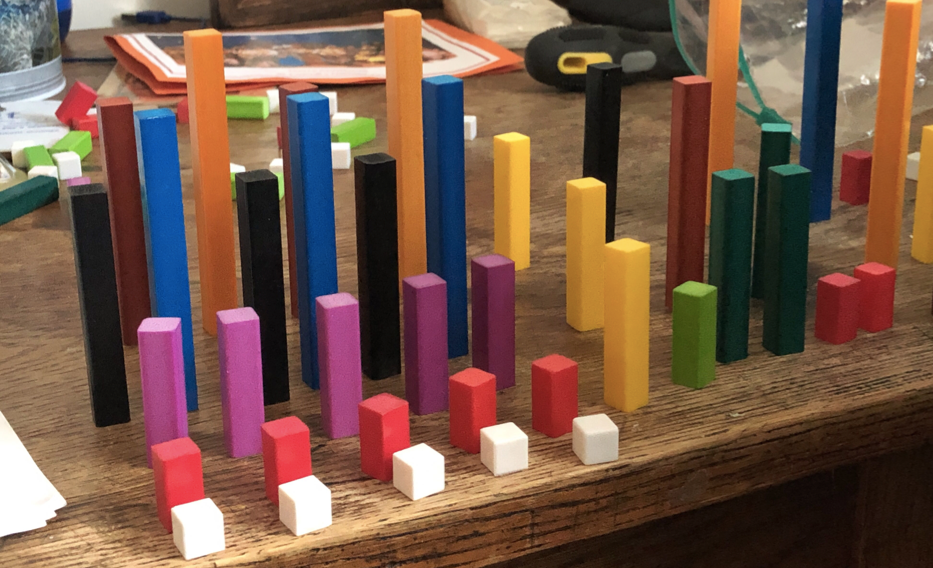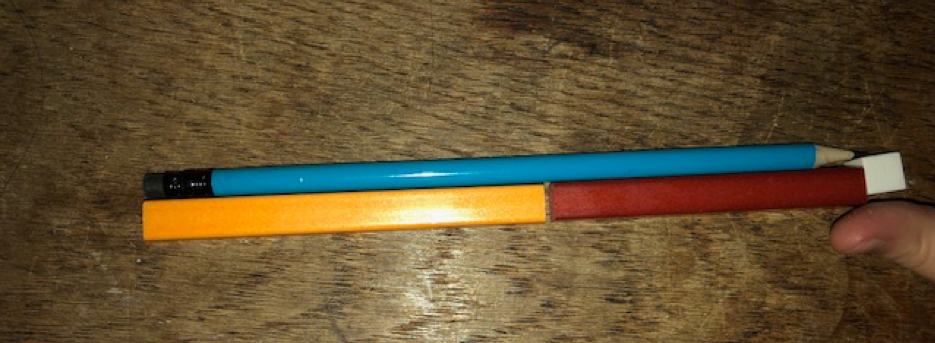A five-year-old’s first engagement with Cuisenaire: Joyful Learning
I’ve used Cuisenaire occasionally in my career. Much of the time it was as an aide in the teaching of fractions to younger secondary pupils. However, this fabulous resource has so much more potential. It can be used to introduce the very basics of arithmetic such as additive relationships, or extended into harder topics such as simultaneous equations, Pythagoras and equation of a straight line.
Allow me to share a reflection of “a learning episode”.
This evening my five-year-old son, who is as inquisitive as children of that age tend to be, spotted a small bag of Cuisenaire rods on my desk. He was immediately drawn to them. “What are those daddy? Can I see them?” The verb “to see”, for a five-year-old is not just an interaction of the eyes and brain. It is a tactile action, it involves touching the object and interacting with it in some way.
He poured all of the blocks over the table, gazing in my direction to ensure that this was OK. Immediately, he began to play with them. He built little patterns and began to group the rods. There is something about these little rods that is inherently enticing.

Mark McCourt had told me that young children will begin to behave mathematically with these blocks, given enough opportunity to play with them. I was stunned, when, after just a few minutes, my son said “Maybe after this I could do it by sizes”. The level of categorising went beyond the first level I’d expected him to consider; colour. Instead it was a mathematical idea. I let him play with them for a while. I was minding my own business, leaving him to it and not prompting him in any way.
All of a sudden, a loud announcement, coloured with the excitement and joy of a profound revelation: “Its colour is its size!” In that moment, these little rods had gone from being toy blocks to being something else. It’s impossible to make inferences about the connections he was making. However, what was to follow demonstrates, to me, that he was thinking hard.

“Orange is the biggest one!”
I’d resisted the urge to prompt or direct him until now, but I couldn’t help myself, I wanted to play too. Displaying a little bit of shock for his benefit I asked him “Is it really bigger than the blue?”
He was, correctly, adamant that it was. Having his conjecture challenged, he did what any mathematician would do – he sought out a proof! Carefully lining up the blue and orange he showed me that there was a gap. “Look – you can put a white one there”.
He’d just modelled a number bond to ten. While he can already “do” addition he hadn’t yet recognised that the calculations he does at school were synonymous with his demonstration with these little rods. I think that will come in time – after all, the pace of progress in his use of the rods is startlingly fast.
He continued to play freely with the rods. He made some domino trails. This is the beauty of this manipulative – there is fun to be had with it! A short while later I saw him looking at the purple and dark green. “This is four more taller than purple”. I was perplexed with this idea of four, as the green is only two blocks more than the purple. I chose not to judge, but instead try to understand his interpretation of the situation. I asked him to show me why.
He motioned with his finger four equal steps from the end of the green to the end of the purple. I suggest that there were two possible thought patterns here: the first is that there was some unit of measurement, known only to him, which was his point of reference. Alternatively, he hadn’t quite grasped the relative size of the white block to the others.
Maybe in asking why, I challenged him in a way that made him reconsider things. He presented me, absolutely delighted with himself, the following set up:

The mathematics is simply pouring out of this free play. These are exactly the sort of comparative models I watched Mark McCourt share with teachers yesterday!
The free play continued with “now I want to count them all”. This was going really well. He had counted past 50 when, all of a sudden, his twin sister appeared. He continued to count but her presence (she was asking me about the rods) put him off a little. He said he thought he’d counted properly, but wanted me to double check. His sister volunteered – she was keen to get involved too. Midway through counting I heard her brother say to her “you’ve missed out all of the fifties and sixties”. He had been listening intently. They decided to count them again together, this timing getting the correct total. I didn’t check the total for them. They have the knowledge between them to be sure of succeeding.
They began to discuss the orange rod. He told her how it was the biggest one. She replied, clearly insulted that he thought she hadn’t realised this “I know! Look – it’s two yellows”. She lined up the rods to show him her thinking. I hoped they’d follow this line of inquiry further, so offered a suggestion “how many white ones to get the orange?”. The guesses were wildly inaccurate. One thousand is the phrase they like to use for “lots of something”, so this was the figure they last mentioned. They each made their own models, slowly and deliberately placed the whites against the orange. This was a real test for their fine motor skills.
“The big one is the same as ten.” I noticed that neither of them said “ten whites”. Could it be that they had stumbled upon the standard numerical values of the rods? I was about to offer another prompt when my son asked me for a pencil, so he could measure it. They have done a little bit of measuring in school recently. Did the number ten resonate with him in some way as to remind him of this?


Before long the pencil was cast aside and a box was to be measured. This looks like a potentially intuitive introduction to the idea of perimeter. Yet more rich mathematical activity.

Measuring round the box
All of the above happened in less than 30 minutes. With no direct instruction from me a whole wealth of possible starting points for further exploration have been encountered. Cuisenaire is an incredibly powerful and versatile manipulative. The extent of how it can be used to support learning and teaching is vast. You can learn more about this by coming along to one of our Concrete, Pictorial, Abstract and Language CPD days.